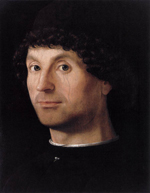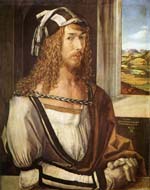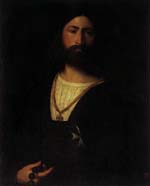| FRANCESCA, Piero della Legend of the True Cross 3. Burial of the Holy Wood 1452-66 San Francesco, Arezzo |
Fresco in the church of San Francesco, in the Tuscan town of Arezzo. Notice partially lined separate hosen with stirrup foot, shirts, underwear. | |
 |
FRANCESCA, Piero della Legend of the True Cross 7. Finding and Recognition of the True Cross 1452-66 San Francesco, Arezzo |
Fresco in the church of San Francesco, in the Tuscan town of Arezzo |
 |
FRANCESCA, Piero della Legend of the True Cross 7. Finding and Recognition of the True Cross, detail 1452-66 San Francesco, Arezzo |
|
 |
HERLIN, Friedrich Die Flügel des Hochaltars aus der St. Georgskirche 1462 Stadtmuseum Nördlingen |
|
 |
ANTONELLO da Messina Portrait of a Man c. 1475 Galleria Borghese, Rome |
|
 |
ANTONELLO da Messina Portrait of a Man c. 1475 National Gallery, London |
|
 |
ANTONELLO da Messina Portrait of a Man 1475-76 Museo Thyssen-Bornemisza, Madrid |
|
 |
ANTONELLO da Messina |
|
| ANTONELLO da Messina St Sebastian 1476-77 Gemäldegalerie, Dresden |
|
|
 |
ANONYMOUS Beheading of St. John the Baptist, from the Altar 1494 Benedictine Abbey Church, Blaubeuren |
The scene to the left is from the Altar below.
|
 |
DÜRER, Albrecht |
Albrecht Dürer (1471 – 1528) was a German artist from Nuremberg. Although he traveled to Venice in 1494-1495, the portraits included here are interpreted as representing German dress. |
| CRIVELLI, Carlo St Roch c. 1493 Wallace Collection, London |
Although Carlo Crivelli was born in Venice, he spent most of his life outside the Veneto. | |
 |
DÜRER, Albrecht Self-portrait at 26 1498 Museo del Prado, Madrid |
|
 |
VECELLIO, Tiziano (Titian) |
"On 8 May 1512, on an application from Nicolò Grimani, the Senate gave its full attention once more to the subject of dress. ...The description of the styles forbidden to [young men] was remarkably similar to that of those condemned in 1506 and 1509. Shirts – camise – in the French style were not to be gathered up at the throat a la francese. Ziponi must not be padded (interlined?) except at the neck and crosswise, an order which was probably directed against the fashion for quilted ziponi made in expensive stuffs of the kind familiar from the painting by Titian often thought to be of Ariosto. The sitter in this painting also wears a shirt gathered up in what was probably thought to be the 'French' fashion. This has also been regarded as a self portrait. If the painting does represent a Venetian, a problem is posed by the presence of a well-trimmed beard. From his dress the sitter is certainly not wearing mourning."[1] |
 |
VECELLIO, Tiziano (Titian) The Concert c. 1510 Galleria Palatina (Palazzo Pitti), Florence |
"Whereas the numerous paintings by Titian and Palma Vecchio of lovely young women, usually labeled Vanity, Beauty or Flora, can fairly safely be assumed to be portraits of Venetian prostitutes, it is difficult to be sure that the paintings of young men, such as Titian's Man with a Glove, do represent inhabitants of the city of Venice. No documentation seems to tie any of them securely to a specific family. The group of musicians generally called the Concert, which has been variously ascribed to Titian and his contemporaries, probably does portray Venetians. One of the three is a cleric and one perhaps not a monk but, from the expensive fur lining to his sleeves, more probably a togato. The third, a youth, wearing, in the main, a festive version of what would be the logical development of the Venetian fashion by about 1515, wears, however, a hat which would be difficult to accept as Venetian except, perhaps, in the theatre."[2] |
 |
VECELLIO, Tiziano (Titian) A Knight of Malta 1510-15 Galleria degli Uffizi, Florence |
|
 |
LOTTO, Lorenzo St Dominic Raises Napoleone Orsini 1513-16 Accademia Carrara, Bergamo |
References
1. Stella Mary Newton, The Dress of the Venetians, 1495-1525 (Aldershot, England: Scolar Press, 1988), 41-43.



